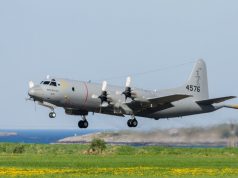The Royal New Zealand Air Force has retired the first of six P-3K2 Orion airborne surveillance and reconnaissance aircraft in a final flight ceremony at Auckland air force base.
The Orion NZ4203 bowed out of service after 55 years of operations and more than 27,000 flying hours.
The RNZAF first started flying the type after the first five airframes (NZ4201 – NZ4205) were delivered in 1966. In 1985 an ex-Royal Australian Air Force P-3B was purchased (NZ4206). All six aircraft were upgraded (avionics and radio systems) under project RIGEL in the early 1980’s and the re-designation P-3K was applied to these aircraft.
Following this, the aircraft were re-winged under project KESTRAL extending their service life. Since going through the latest upgrade program to modernize navigation, mission and communications, the aircraft are now designated the P-3K2.

The service employs the P-3K2 for airborne surveillance and reconnaissance of New Zealand’s areas of economic interest, exclusive economic zone, the South Pacific, and the Southern Ocean including Antarctica in support of the Commission for the Conservation of Antarctic Marine Living Resources.
They provide a range of services to Government agencies (including Ministry for Primary Industries, New Zealand Customs and Police, and Department of Conservation) and the community (including search and rescue missions, humanitarian relief and support in the event of natural disasters).
Over the last few years, the country regularly deployed the aircraft in support of United Nations Security Council (UNSC) sanctions on North Korea.
The Orion fleet will gradually be replaced by the newer and more capable P-8A Poseidon.
New Zealand signed contracts for the purchase of the Poseidon submarine hunters and maritime patrol aircraft in 2018, with the first scheduled to arrive in 2023.



























